Today in Tedium: If there’s something I hope that people take away from this newsletter that I’ve worked on for five and a half years now, it’s that, you should take a chance and try something, because you never know what might happen. Perhaps you might change the world. Maybe you might fail, but that failure could be memorable. Maybe you might pull off something like the Fox Television Network, which became a major success upon its 1987 primetime debut thanks in no small part to a well-connected housewife who’s related to the current RNC chair. But not everyone succeeds with a big idea, and Fox wasn’t the first to try to become a fourth network in the U.S., and some failed harder than others. Some didn’t even make it a calendar year. In honor of the Fourth of July, today’s Tedium digs into the long line of failed fourth networks. You may want to change the channel. — Ernie @ Tedium
*A quick note: Our last issue didn’t hit some readers on the normal publishing schedule due to a sending error, though we did eventually send them the issue to those readers. We regret the error and suggest you give the issue a fresh look.*
The Prepared is a weekly newsletter that usually includes cool manufacturing videos
In this week's issue: The USDA's recommendation list of hand tools for trail work, subtle guerrilla tactics for destroying bronze statues, and a meta-discussion on running a newsletter business through Patreon. Subscribe for free here!
Today’s Tedium is sponsored by The Prepared.
“The time is here for America to revise its concepts of its living rooms, its classrooms, its town halls. The time is here to become familiar with new measurements of human progress … economic, political, scientific. For full-scale Television is near … a force of unparalleled power.”
— A quote from a 1944 ad published by the early electronics and television company, DuMont. The ad, titled “Are You Ready for Television,” was published in the waning days of World War II, and presaged DuMont’s early role in the history of television, as the first example of a “fourth network” in the history of American television. The DuMont network, which competed with ABC, NBC, and CBS over an eight-year period, is widely considered innovative—having moved TV away from its initial model of letting an advertiser sponsor an entire show and making up for its lack of talent from radio with a huge amount of ingenuity. While the network failed, it was considered groundbreaking for its time. (One could make the case, by the way, that DuMont was technically a third television network, as it briefly predated ABC, but ABC usurped it.)
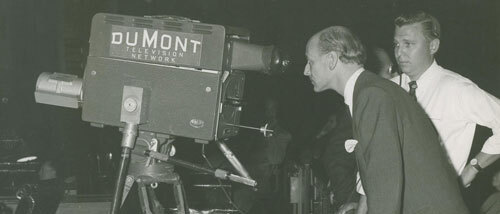
(via The Metropolitan Opera)
The three decades in the wilderness between DuMont and Fox
In many ways, the demise of the DuMont network left a gap in television that many thought needed to be covered. For one thing, there were suddenly lots of independent local stations in need of content to put on the air every night; for another, it seemed like somebody would get it right—and would reap the financial benefits as a result.
But in truth, it was far harder than it looked. There was a gap of almost exactly 30 years from the date in early August of 1956 when the DuMont network aired its final broadcast, a boxing match, and TV viewers got their first taste of the Fox network with the Joan Rivers-helmed The Late Show in October of 1986.
In between, numerous would-be television entrepreneurs tried and failed to fill the gap. But the things that tripped up DuMont also caused wannabe successors to stumble. As the television and radio critic Lawrence Laurent wrote in 1966, the idea of building a TV network, already not easy, was actually harder than it looked:
Networking is one of the most curious businesses in this economy. The network, as a central source for programming and sales, acts as kind of a broker for affiliated stations. That is, the network buys time from affiliated stations (usually at 30 per cent of a station’s price card) and sells the time to national advertisers.
The network is also supposed to pay the cost of a program and to pay the cost of delivering it, via the microwave system of the American Telephone and Telegraph Co.
Profit, If any, comes from what’s left of the advertising revenue after stations, program producers and the AT&T are paid off.
This system of revenue and costs may explain the rule of thumb that networking isn’t profitable, but that stations owned by a network are goldmines.
So, to put this all another way, the real money in TV, at least in the mid-1960s, was in owning the stations. (As Laurent notes, ABC the network lost $6.5 million in 1965, but ABC the local station owner made $25.5 million that same year.) However, in large part because of the natural conflicts of interest that come with owning lots of TV stations, the Federal Communications Commission limited how many stations a single network could own.
This rule effectively sank the DuMont Network, which didn’t have a dominant radio network to fall back on, as CBS and NBC did, nor an owner that also owned a major chain of movie theaters, as ABC did. (As I wrote back in May, a consent decree effectively barred movie studios from owning movie theater chains, but they didn’t say movie theater chains couldn’t own TV networks.)

The result was that nobody figured out how to solve the problem until the 1980s, when the Fox Network used a series of loopholes to get around the FCC’s more arduous rules. Essentially considered a group of channels with the same owner in the eyes of the law, Fox was not initially bound by rules that required it to air certain kinds of content, and aired just below the amount of content that would have technically made it a network. (Compare this Trojan horse approach to, say, what Uber did.) The result was that the channel took a number of years to fully fill out its schedule—and by the time it did, it was everywhere.
But in the years between DuMont and Fox, a lot of people tried—and failed—to turn their dreams of a national “fourth network” into reality. Some were more successful than others.
$3.2M
The amount that Mobil, the oil company, paid to bankroll “Ten Who Dared,” a 10-week BBC-produced history show, to air on TV stations around the country in 1976. Mobil, which also underwrote Masterpiece Theatre to great success, aired the show as part of an occasional network it created called the “Mobil Showcase Network.” The reason for the show was simple: It wanted a venue to run its pro-oil ads in an unvarnished way, and the best way to do it was to simply buy out a bunch of TV stations for a night. (It helped that the show was actually good, and the ads were only aired around the main content.) The oil company continued to run different series on local TV networks through 1984.
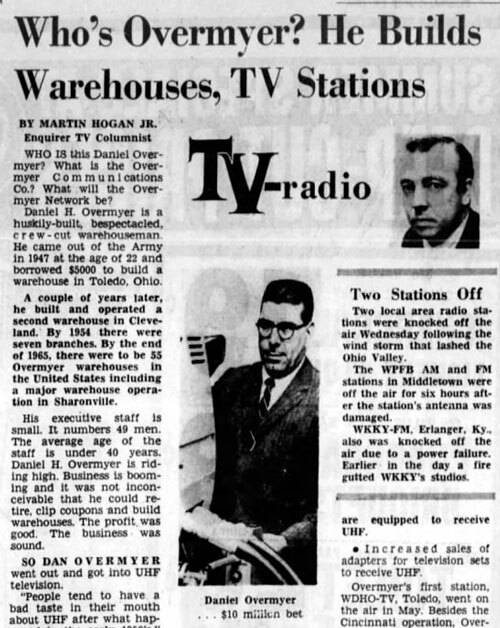
A 1966 Cincinnati Enquirer article about Daniel H. Overmyer, the warehouse entrepreneur who tried to build a TV network.
The warehouse king that built a network that lasted a month
If you were “the king of warehousing,” what would you do with your money in the hunt of your next business endeavor?
Well, in the case of Daniel H. Overmyer, he took the steps to launch his own TV network—and a very ambitious one at that.
Based in Toledo, Ohio, Overmyer was an early investor in UHF-based technology, having received a permit for WDHO-TV (now known as WNWO-TV), which launched in May of 1966, and was one of a network of stations that he brought online.
As writer K.M. Richards writes on there site about the history of UHF television, Overmyer was initially seen as something of a savior for UHF:
At first glance, Overmyer seemed to be exactly what the growing UHF industry needed: He was a self-made Toledo businessman whose extensive interests included trucking and warehouse holdings, and the weekly Toledo Monitor newspaper. His financial statement at the time showed ownership of 200 warehouses in 56 cities worth $35 million dollars, plus a leasing company and 80% ownership of Progress National Bank for a total somewhere in the neighborhood of $50 to $60 million. Overmyer also apparently had the drive to make a successful run at broadcasting; shortly after the FCC filing for Toledo, his executive vice president and managing director Robert F. Adams (formerly general sales manager of WBKB-TV under ABC in Chicago) said they “hoped to acquire the full complement of AM, FM and TV properties allowed under the FCC’s rules as soon as feasible.”
The network, first publicly announced in 1966, aimed to have a mixture of cultural, sports, and religious programming, and had nearly three dozen affiliates signed up by the middle of that year. Oliver Treyz, an early ABC television president, was brought on board to run the network.
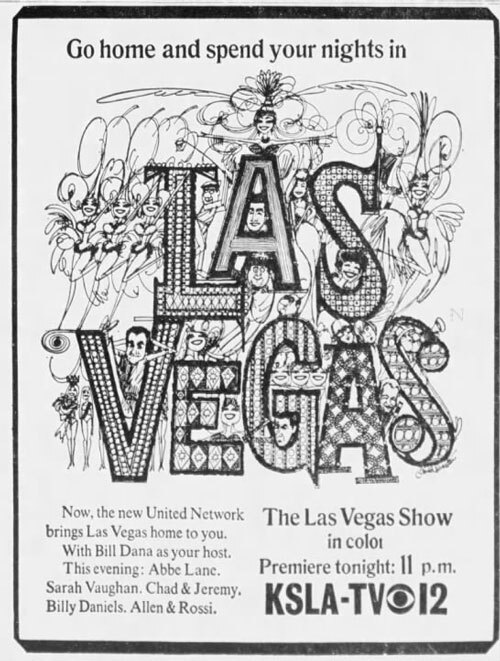
An ad for The Las Vegas Show, the only output that Overmyer’s network ever aired.
But in the end, the network, built around a Las Vegas-themed variety show hosted by a frequent Ed Sullivan Show guest, was too big for the king of warehousing’s britches. In late 1966, something appeared to spook Overmyer about the idea of the network, which he had been promoting for many months in the press, and he tried to disband the network, only for Treyz to keep it alive, leading to its sale to a group of businessmen under the name the United Network.
The network first went on air on the first day of May, 1967 … and went off the air on the first day of June, 1967. It was a bit of a mess, with money bleeding left and right, and despite the relatively high viewership of The Las Vegas Show, the variety showcase hosted by Bill Dana, the network did not survive.
Part of the problem was timing: May is usually when a TV season ends, rather than begins. The effort was bold nonetheless, with around 125 affiliates airing the two-hour show, but it was not something that could be salvaged.
Charles W. Shoop, an early employee of the Overmyer network, made it clear that the work was a labor of love in a statement to the House of Representatives Special Subcommittee on Investigations of the Committee on Interstate and Foreign Commerce.
“I could fill a book describing the hard work; heartaches; disappointments; and also some of the rare good accomplishments that came forth from the ‘rise and fall of the Fourth Network,’” he wrote in his letter to the subcommittee.
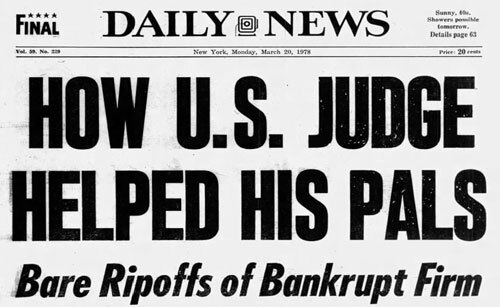
Overmyer is one of the “pals” in this 1978 New York Daily News headline.
The king of warehousing did not survive the situation unscathed—and by 1973, his warehousing company had filed for bankruptcy, with his group of local TV stations following a few years later. I’ll spare you the details, because there are a lot of them, enough to fill a whole issue of Tedium, but let’s just say that Overmyer’s business problems caught up with him in a big way. he was eventually charged with bankruptcy fraud in the mid-1980s as his business empire spiraled out of control, and later spent six months in prison.
It lasted a month, but left a pretty wild story in its wake.

The NTA Film Network promoted itself with this bizarre ad showing a child birth.
Five other examples of failed “fourth network” endeavors
- Pat Weaver’s unnamed fourth network. Soon after the DuMont network went off the air, early NBC TV executive Pat Weaver spoke repeatedly of launching a fourth network, saying that he had lined up 40 local channels to carry it—though there’s no evidence he actually pulled it off. “Every major city can afford to carry at least four commercial TV stations, three to take care of the networks and a fourth as an independent,” he argued at the time according to the St. Louis Globe-Democrat. “Our aim is to provide viewers with alternatives to the narrow and limited programming in which current TV is wallowing.”
- Unisphere Broadcasting System. This attempt at a network, first planned in the mid-1960s, was spearheaded by Vincent C. Piano and intended to have a prime-time component, but eventually evolved into a sports network that focused on airing college sports under the Mizlou Television Network name after Piano struggled to sign up network affiliates.
- Hughes Television Network. Born from the basis of a TV network intended to air away games for local sports teams, reclusive billionaire Howard Hughes bought the network—which originally had the imaginative “Sports Network” name—as an alternative to his efforts to purchase ABC in the late 1960s. Beyond sports, the network aired one of the first standalone televised Muppets specials, The Frog Prince. (Side note: Around the same time, Hughes purchased a TV station near his home, KLAS, that effectively became a personal VCR of sorts.)
- Prime Time Entertainment Network. Forgotten in the context of UPN and The WB despite being created by many of the same players, this early-’90s network—more a setup for syndication, really—is best known as being the initial home of the iconic sci-fi show Babylon 5. It was negatively affected by Warner Bros. and Chris-Craft Industries deciding to back one of the two new channels, which started airing two years after PTEN started.
- NTA Film Network. This early network, which was backed by Twentieth Century Fox roughly 30 years before the Fox network appeared and was promoted with this over-the-top ad, was designed to give film studios an inroad into television productions, including airing the original version of Divorce Court, a show that remains on the air today. It also offered TV stations access to feature films. Like PTEN, it was eventually regarded to be something of a syndication service, rather than a traditional network, and it fell apart in the early 1960s.

Star Trek: Phase II was intended to be the centerpiece of Paramount’s late-1970s network. It was never made.
How an all-star team of major executives nearly launched a major network as a vehicle for a Star Trek reboot … and how that network eventually inspired every successful “fourth network”
Doesn’t it seem like Barry Diller has been around basically forever?
Responsible for pioneering the movie-of-the-week concept while at ABC in the late 1960s, Diller became an iconic media mogul in the 1980s and 1990s before finishing out his long career with the internet giant IAC. (Which, fun fact, was initially built as a vehicle for increasing the reach of the Home Shopping Network.) But in the late 1970s, as head of Paramount Pictures, he took his first stab at becoming the founder of a fourth network. And he had many of the elements to pull it off at the time—only for it to get pulled down by internal politics.
The key factor for Paramount? Star Trek, which the company owned, was an absolutely massive hit in syndication, with 137 stations airing the show in the mid-1970s. There was clear interest in a new show, and Paramount leaned into that in an effort to build a new network.
The story of the Paramount Television Service, as it would have been called, feels comparable to the basketball “Dream Team” at the 1992 Summer Olympics, with soon-to-be major executives such as Diller, Michael Eisner, and Jeffrey Katzenberg all associated with the effort.
Paramount only planned a single night of programming, but the marquee show would have offered a great launching point for a fourth network: Star Trek: Phase II, a revival of the original series with Gene Roddenberry back as creator and most of the original cast back on board. With Star Trek already a phenomenon, the network would have essentially launched with a guaranteed hit on its hands.
But the effort failed to pick up steam internally, according to the Los Angeles Times, out of concern that the studio would lose tens of millions of dollars in trying to build a new network. Despite the strong interest in new Star Trek series, the channel was not to be, though the work on the unfinished Star Trek revival played directly into the film that appeared in 1979. (The film also had one thing that the series might not have had: Leonard Nimoy, who was in a battle with the studio over royalties at the time the revival series was being considered.)
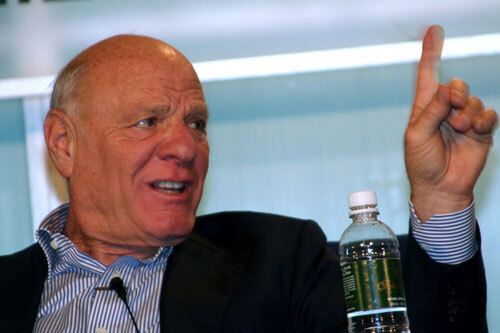
Barry Diller. (Wikimedia Commons)
The effort was the just the first time Paramount tried to launch a fourth network. Diller—who carried a reputation in Hollywood so strong that The New York Times wrote he had “built what is widely regarded as perhaps the best-run, most stable and most consistently successful movie company in Hollywood”—also tried to create a Paramount network around 1984, running into issues with leadership at Paramount’s parent company, Gulf+Western, for a second time. That’s when he left and became the chairman and CEO of 20th Century Fox, where he found someone who was willing to pony up the cash to buy a group of stations—Rupert Murdoch, whose News Corp. acquired Fox in 1985.
“Mr. Diller—who became chairman of Paramount Pictures at the age of 31, ran the studio for a decade and built it into Hollywood’s most consistently successful movie studio before he lost a power struggle and moved across town to Fox in 1984, has the hubris to think he can create the first television network since Leonard Goldenson launched ABC in 1951,” a 1986 New York Times article on the launch of Fox, and Diller’s role in it, stated. (He had the hubris, alright—and it worked after a few tries.)
But the idea for a Paramount network didn’t die with Diller, just as the idea of a Star Trek TV revival never went away with the demise of the Paramount Television Service. In fact, the syndication success of Star Trek: The Next Generation revived interest in the idea—now technically a fifth network, thanks to Fox—around 1989, per the Times, though the feet-dragging at Gulf+Western prevented it once again.
Eventually, it came back with a vengeance in 1993, thanks to a collaboration between Paramount and Chris-Craft Industries’ United Television, which came to be known as the United Paramount Network, or UPN. Problem was, by that time, a fellow major studio, Warner Brothers, had basically the same idea. Both new channels were driven by changes in federal regulations that allowed TV networks to syndicate their own shows—something troubling to both Paramount and Warner Bros., as they each distributed many successful shows in syndication. The net effect was that UPN and The WB went on air at almost exactly the same time.
UPN was not exactly a major success—while it had the successful Star Trek: Voyager and WWE Smackdown was a longtime anchor, many of its other shows (for example, the one based on the work of annoying bad Twitter man) failed to make an impact, and the network merged with The WB in 2006 after eventual Paramount owner Viacom spun off UPN as a portion of the CBS corporation. That lives on today as the long-running “fifth network,” The CW.
In many ways, we eventually got a fourth network because of Barry Diller, who was willing to see this idea through, to bank his reputation on getting it right. Given his key role in this story, we’ll do him a solid and not dwell on the time he tried to turn the USA cable network into a “fourth network” by acquiring a group of Home Shopping Network affiliates.
Even our business heroes sometimes get it wrong.
In many ways, you can connect most of these efforts to build a “fourth network” together really easily, in part because they were all using the same parts—literally, in the case of DuMont and Fox.
The initial purchase of the MetroMedia-owned stations by News Corp. kicked off the rise of a long-standing fourth network, sure, but those same channels were also the very same ones that DuMont had abandoned three decades earlier, meaning that Fox is in many ways a modern revival of an old idea.
I think now how easy it is to start a “network” of your own. Sixty years ago, you would have needed a lot of money, a construction crew to build a new channel, a large staff, on-air talent, and the ability to fund the project for years to come.
It was an absolutely massive risk, and you needed to have a lot of money to invest into it. That someone like Howard Hughes could buy a TV station to act as his own personal Netflix was an extreme rarity, but it nonetheless reflected a time when a “fourth network” could be some rich person’s plaything if they pull it off.
Even during the early days of cable the work of getting off the ground wasn’t quite so complex.
Nowadays, though, starting your own channel is as easy as hitting a button on YouTube. And it’s so easy that creators on that network don’t even need high-money alternatives like Quibi.
What a world.
--
Find this one an interesting read? Share it with a pal! And thanks again to The Prepared for sponsoring.




